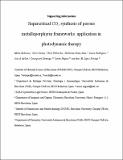Por favor, use este identificador para citar o enlazar a este item:
http://hdl.handle.net/10261/295312COMPARTIR / EXPORTAR:
 SHARE SHARE
 CORE
BASE CORE
BASE
|
|
| Visualizar otros formatos: MARC | Dublin Core | RDF | ORE | MODS | METS | DIDL | DATACITE | |

| Título: | Supercritical CO2 Synthesis of Porous Metalloporphyrin Frameworks: Application in Photodynamic Therapy |
Autor: | Kubovics, Márta; Careta, Oriol; Vallcorba, Oriol CSIC ORCID; Romo Islas, Guillermo; Rodríguez, Laura CSIC ORCID; Ayllón, Jose A.; Domingo Pascual, M. Concepción; Nogués, Carme; López Periago, Ana M. CSIC ORCID | Fecha de publicación: | 14-feb-2023 | Editor: | American Chemical Society | Citación: | Chemistry of Materials 35(3): 1080–1093 (2023) | Resumen: | A series of porous metalloporphyrin frameworks prepared from the 5,10,15,20-tetra(4-pyridyl)porphyrin (H2TPyP) linker and four metal complexes, M(hfac)2 M = Cu(II), Zn(II), Co(II), and Ni(II) (hfac: 1,1,1,5,5,5-hexafluoroacetylacetonate), were obtained using supercritical CO2 (scCO2) as a solvent. All the materials, named generically as [M-TPyP]n, formed porous metal-organic frameworks (MOFs), with surface areas of ∼450 m2 g-1. All MOFs were formed through the coordination of the metal to the exocyclic pyridine moieties in the porphyrin linker. For Cu(II), Zn(II), and Co(II), incomplete metal coordination of the inner pyrrole ring throughout the structure was observed, giving place to MOFs with substitutional defects and leading to a certain level of disorder and limited crystallinity. These samples, prepared using scCO2, were precipitated as nano- to micrometric powders. Separately, a layering technique from a mixture of organic solvents was used to crystallize high-quality crystals of the Co(II) based MOF, obtained with the formula [{Co(hfac)2}2H2TPyP]n. The crystal structure of this MOF was elucidated by single-crystal synchrotron X-ray diffraction. The Zn(II)-based MOF was selected as a potential photodynamic therapy drug in the SKBR-3 tumoral cell line showing outstanding performance. This MOF resulted to be nontoxic, but after 15 min of irradiation at 630 nm, using either 1 or 5 μM concentration of the product, almost 70% of tumor cells died after 72 h. | Versión del editor: | http://dx.doi.org/10.1021/acs.chemmater.2c03018 | URI: | http://hdl.handle.net/10261/295312 | DOI: | 10.1021/acs.chemmater.2c03018 | ISSN: | 0897-4756 |
| Aparece en las colecciones: | (ICMAB) Artículos |
Ficheros en este ítem:
| Fichero | Descripción | Tamaño | Formato | |
|---|---|---|---|---|
| Kubovics_ChemMater_2023_editorial.pdf | Artículo principal | 10,72 MB | Adobe PDF |  Visualizar/Abrir |
| Kubovics_ChemMater_2023_suppl_editorial.pdf | Información complementaria | 411 kB | Adobe PDF |  Visualizar/Abrir |
CORE Recommender
SCOPUSTM
Citations
3
checked on 06-abr-2024
WEB OF SCIENCETM
Citations
2
checked on 29-feb-2024
Page view(s)
28
checked on 15-abr-2024
Download(s)
61
checked on 15-abr-2024
Google ScholarTM
Check
Altmetric
Altmetric
Este item está licenciado bajo una Licencia Creative Commons

